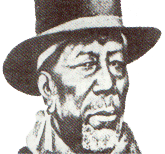Battle of Berea
The Battle of Berea took place on 20 December 1852 during the XhosaWars in what was then Basutoland (now Lesotho). The confrontation was between an ill-planned English punitive expedition led by Major-General Sir George Cathcart and the native forces of the Sotho chief Moshoeshoe and resulted in the English forces being repulsed.[1]
| Battle of Berea | |||||||
|---|---|---|---|---|---|---|---|
| Part of the Xhosa Wars | |||||||
| |||||||
| Belligerents | |||||||
|
| Sotho people | ||||||
| Commanders and leaders | |||||||
| Major-General Sir George Cathcart | King Moshoeshoe I | ||||||
| Strength | |||||||
| Approx. 1000 British Army troops | Unknown | ||||||
| Casualties and losses | |||||||
| 38 British killed | c.50 Sotho killed | ||||||
Prelude

Following the defeat of an ill-armed and inadequate punitive force at Viervoet the previous year by the Sotho tribe of Basutoland under their leader Moshoeshoe, the British Major-General Cathcart gathered together at Platberg in the Free State an overpowering force of over 2,000 men. The force consisted of infantry detachments of the 2nd (The Queen's Royal) Regiment of Foot, the 43rd (Monmouthshire) Regiment of Foot, the 73rd (Highland) Regiment of Foot Regiment, the 74th (Highland) Regiment of Foot and the 1st Battalion, The Rifle Brigade supported by cavalry and artillery.
Believing that such a force would totally overawe the Sotho tribe, Cathcart demanded reprisals of 10,000 cattle and 1000 horses within 3 days, threatening to march into Moshoeshoe's heartland and collect any unpaid debt by force. Only 3000 cattle were delivered in the time allowed and Cathcart therefore organised the threatened invasion. He opted to take only half his available strength, about 1000 men, leaving behind the 2nd Foot, most of the 74th Foot, some of his cavalry and his smaller artillery. No spare ammunition for the infantry would be taken.
Invasion

Moshoeshoe had established his headquarters on the steep-sided Berea plateau at Thaba Bosiu in the Phuthiatsana valley. Cathcart's tactics were to advance on Thaba Bosiu in three widely separated columns and link up at midday in front of the stronghold. Any available cattle were to be rounded up and driven back to base.
The left column of 233 cavalry under Lieutenant-Colonel G.T.C. Napier of the Cape Mounted Rifles, made up of elements of the 12th Royal Lancers and the Cape Mounted Rifles, were to circumnavigate the Berea plateau to the east. The main column under Sir William Eyre were to cross the reamohetse sello′s plateau and the right column under Cathcart would skirt the plateau to the west.
In the event Napier's column, accompanied by captured cattle, were ambushed and forced to return to base. Eyre's column was also so engrossed in rounding up cattle that they were hours late arriving at the rendezvous, having also been harried by Moshoeshoe's cavalry. Cathcart's column arrived safely at Thaba Bosiu to find themselves surrounded at a safe distance by thousands of Sotho mounted cavalry. He was later joined by Eyre's troops and retreated to a safe place to make camp for the night. The following day they made their way back to the border.
Aftermath
Cathcart had lost the use of his cavalry, had a significant number of men killed and had limited ammunition. He could not have been sure of defeating the enemy. Moshoeshoe had lost some 5000 cattle but would have realised that had he attacked in numbers and defeated the British force he would inevitably have been subsequently overpowered by a larger one.
However Moshoeshoe was also under threat from other tribes and from Boer encroachment and decided to sue for peace with the British, ultimately requesting the protection of the British Crown.
References
- "BOTCHED ORDERS OR INSUBORDINATION? The battle of Berea revisited". The South African Military History Society. Retrieved 14 March 2017.
External links
- Basotho Wars
- Anglesey, Lord. A History of the British Cavalry 1816-1919: Volume 3: 1872-1898. p. 175.
- Basutoland Roll of Honour